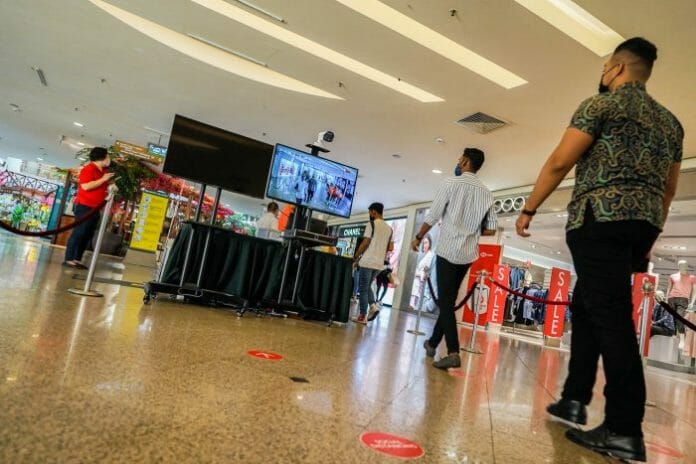While the outlook for the Malaysian consumer for 2021 is still positive, the real household spending growth
forecast for the year is 3.0% y-o-y, from the previous forecast of 11.0% y-o-y according to Fitch. Even though positive, the rating agency highlights this is partly caused by base effects. The estimated -3.7% y-o-y drop in 2020 real household creates a low y-o-y base for 2021 to grow from. In nominal terms, total household spending will be worth RM900 billion in 2021, slightly lower than the RM905 billion estimated for the pre-Covid-19 environment in 2019.
Retail sales in Malaysia continue to be weak over first half of this year, with growth mainly coming from a low base. This weakness stems from the lack of significant relaxation in restrictions, impacting both consumers and retailers. Also to take note note is that continued restrictions on inter-district and inter-state travel within the Klang Valley which accounts for approximately 60% of retail sales in the country, will delay this recovery. However, these restrictions continue to speed up the development of the country’s e-commerce sector. The online retail sales index, which portrays e-commerce activity continued to surged to record 23.1% growth y-o-y. Consumer confidence has been improving from the deep slump caused by the initial Covid-19 pandemic. However, it has yet to reach its pre-Covid-19 level, which we believe will only happen once the country is able to vaccinate enough of its population to allow for the gradual lifting of restrictions.
Forecast revisions for consumer spending over the year are driven by a number of factors. These include the
continued restrictions placed on non-essential retail, movement restrictions and limited fiscal space to offer renewed
support. In line with this, Fitch’s Country Risk team has revised down 2021 real GDP growth forecast to 4.9% from
10.0% previously. The recent lockdown will result in a resurgence in unemployment, which would significantly dim the prospects for a recovery in domestic demand, with government consumption unlikely to provide meaningful
support. Government stimulus measures (outlined in more detail in previous Consumer Outlook modules) enabled
some protection to Malaysian consumers and the nation’s economy over 2020. Unemployment rates in 2021 will remain elevated, as businesses (especially small and medium-sized enterprises) slowly recover and increase employment. As such, the unemployment will only begin falling from second half of this year onwards.
While Malaysia was able to relax restrictions at certain stages over the past year, the general theme has been relatively stringent restrictions. As of writing, the country remains under strict nationwide Covid-19 measures through to an undetermined date. The government has noted that these measures will remain in place until daily cases fall below 4,000, however, current daily cases are averaging approximately 7,000. The ongoing restrictions, known as movement control orders, limit business activity and travel. On-site operations of nonessential sectors are suspended. Shopping malls are closed, except for supermarkets, food establishments, and other essential businesses.
According to the Oxford Covid-19 Government Response Tracker (a composite measure that takes the above into
account to highlight the strictness of restrictions in a country), Malaysia’s restrictions are still relatively in line
with restrictions introduced during the first wave of Covid-19 infections in March 2020. Latest data, reported a stringency score of 80.6 out of 100, significantly higher than the global average of 50.2 out of 100.
Over 2020, the Malaysian government announced five stimulus packages, to a total of RM72 billion or 5% of GDP. Part of these packages included cash transfers to low income households, wage subsidies to help employers
retain workers, and temporary tax and social security relief. Additionally, the government released the 2021 budget, which included RM7 billion spending on Covid-19-related measures, carried over from the packages announced in 2020. As part of this budget, the government will replace the Bantuan Sara Hidup aid with Bantuan Prihatin Rakyat, which is expected to benefit 8.1mn individuals with an allocation of RM6.5 billion.
This year so far, the government has launched two new packages, to a total of RM35 billion. Key initiatives include accelerated social security payments under the existing programs, the expansion of the wage subsidy programme, additional cash payments to the vulnerable, as well as transfers to the most impacted by the recent surge (including an extension of the wage subsidies program). However, the government is reaching a point where they may not be able to finance the current plans, or other future stimulus plans. Any stimulus measures that will be announced in the coming weeks is unlikely to top what was announced last year given the constraints the government faces, with the stimulus already being relatively small compared to what other economies fielded, such as Singapore and Hong Kong. The high public debt load is likely to have a negative impact on investor sentiment towards Malaysia and could raise its borrowing costs further. This as a significant risk to the Malaysian consumer, who is likely to face another six months of restrictions and subsequent job losses and/or pay cuts.
In March 2021, it was reported that the Finance Ministry was studying the possibility of a consumption tax to be
introduced once the economy has recovered, as a way to widen the revenue base. This announcements will ultimately see Malaysian households pay more tax over the medium term. These are the first announcements by the government to reduce the tax deficit and any future plans, as a clear risk to the disposable incomes of households over the medium term.
The global view for a notable recovery in consumer spending relies on the ability of authorities to vaccinate a large
enough proportion of their populations and thereby experience a notable drop in Covid-19 infections and a decline in
death rates. Both these factors will lead to government’s gradually lifting restrictions, which will boost consumer
confidence and retail sales. While the Health Ministry has developed a Covid-19 national vaccination plan,
whereby between 60% and 70% of the population (20mn to 23mn people) will need to be vaccinated to achieve herd immunity, the vaccination drive has so far been slow. As of July 11 2021, approximately 24.2% of the Malaysian population had received a single dose of a vaccine.
Fitch’s forecasts take into account risks that are highly likely to play out in 2021, such as the easing of government support, a reduction in restrictions and vaccine rollout. However, there are risks to the outlook that if they do start to play out will lead to forecast revisions.









